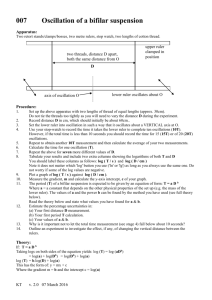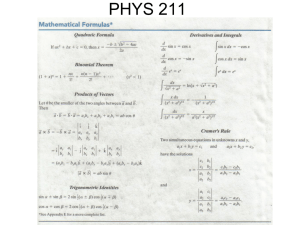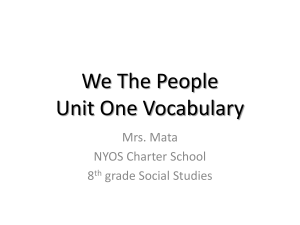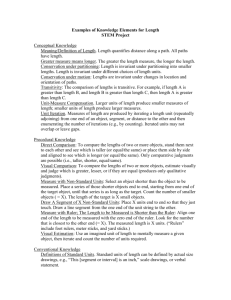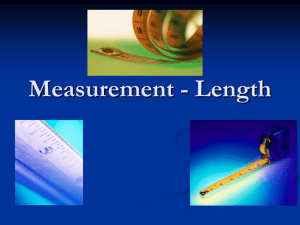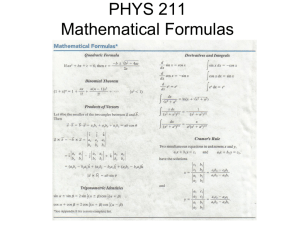Let’s Measure! – CSOs
advertisement
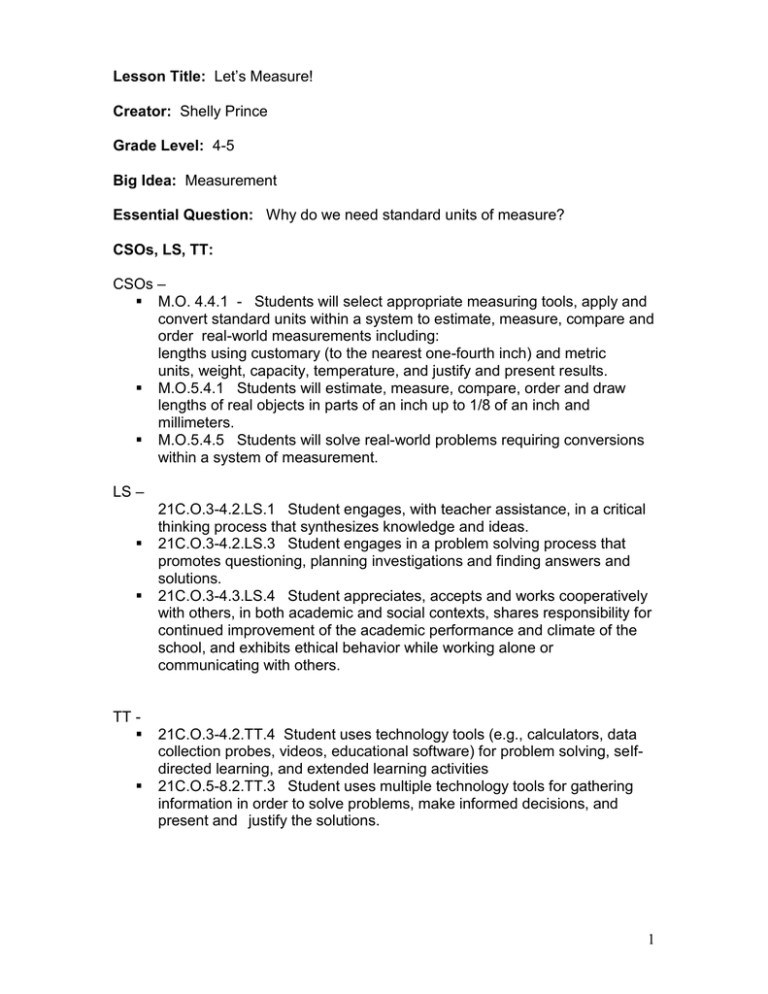
Lesson Title: Let’s Measure! Creator: Shelly Prince Grade Level: 4-5 Big Idea: Measurement Essential Question: Why do we need standard units of measure? CSOs, LS, TT: CSOs – M.O. 4.4.1 - Students will select appropriate measuring tools, apply and convert standard units within a system to estimate, measure, compare and order real-world measurements including: lengths using customary (to the nearest one-fourth inch) and metric units, weight, capacity, temperature, and justify and present results. M.O.5.4.1 Students will estimate, measure, compare, order and draw lengths of real objects in parts of an inch up to 1/8 of an inch and millimeters. M.O.5.4.5 Students will solve real-world problems requiring conversions within a system of measurement. LS – TT 21C.O.3-4.2.LS.1 Student engages, with teacher assistance, in a critical thinking process that synthesizes knowledge and ideas. 21C.O.3-4.2.LS.3 Student engages in a problem solving process that promotes questioning, planning investigations and finding answers and solutions. 21C.O.3-4.3.LS.4 Student appreciates, accepts and works cooperatively with others, in both academic and social contexts, shares responsibility for continued improvement of the academic performance and climate of the school, and exhibits ethical behavior while working alone or communicating with others. 21C.O.3-4.2.TT.4 Student uses technology tools (e.g., calculators, data collection probes, videos, educational software) for problem solving, selfdirected learning, and extended learning activities 21C.O.5-8.2.TT.3 Student uses multiple technology tools for gathering information in order to solve problems, make informed decisions, and present and justify the solutions. 1 Launch/Introduction: (suggested time 15-25 minutes) Activating Prior Knowledge 1. Post the Essential Question and draw students’ attention to it. Give them a minute to think about how they would answer this question, and have them jot their answers down on sticky notes and place the notes around the question. You will refer back to them at the end of the lesson. 2. Pose the situation to students: Let’s say that we are getting a new student in our class, and we need to adjust the height of the desk for him. What kind of instrument would we use the find the measurement? What if we didn’t have a ruler or yardstick available to us? Could we still find a way to convey the height in some other terms? 3. One way to help students begin to think of alternate ways to measure the desk would be to discuss ancient ways of measuring length. Lead them in a discussion of the following ancient measurements, allowing the students to demonstrate each one: cubit – the length of the forearm from elbow to the end of the fingers digit – the width of a finger fathom – the length of a man’s outstretched arms from fingertip to fingertip foot – the length of a man’s foot handspan – the distance from the tip of the thumb to the tip of the little finger when the hand is fully extended league – the distance a person, or a horse, can walk in one hour of time pace – a deep or “giant” step palm – the width of a human hand at its widest point 4. Have students trace a hand with their fingers extended and closed against one another and their thumb closed against the side of their hand. Then tell them to cut out the palm unit and use it to measure the width of their desks in palms. 5. Using a document camera or a transparency on an overhead projector, record the measures of the palm widths of several students for the class to view. Help students see that the measurements vary from person to person and that desks measured with palm measures would be different sizes for most of the students in the class. 6. To illustrate the point, use palm cutouts that were prepared beforehand, showing the palms of a baby, a child, an adult male, and an adult female. Ask the students, “How can we use the information that we have collected on palm width to help ensure that two people could measure a desk independently with palms and come up with fairly consistent measurements?” Discuss with students how using one palm width as a standard would help achieve consistency among measures. 7. Now give every student a “standard” size palm that has been prepared beforehand. Using this palm of the same size, have students re-measure 2 the width of their desks and discuss the greater consistency in measures. Specialized Vocabulary Development – These are terms that will be introduced through this first lesson on measurement. Some terms such as measurement and length are essential terms for students to add to their math vocabulary, while other terms, such as handspan and palm are only necessary for the success of this lesson. The terms that are essential for math understanding should be reviewed in subsequent lessons and at the end of the measurement unit. A game format, such as math vocabulary dominoes could be used as an informal assessment of students’ mastery of the essential word meanings. A domino template for writing in your own words and student friendly definitions is included with this lesson. measurement measure length palm handspan pace cubit units precise digit fathom foot league Investigate/Explore: (suggested time varies from 30-40 minutes) 1. Arrange students in pairs, and distribute two connecting cubes and two sheets of differently colored paper to each pair. 2. Explain to students that they will be working in pairs to make a new style of ruler that they will then use to measure the lengths of objects in the classroom. Tell them to use the two cubes as their unit and to begin by measuring off lengths of paper that are equal to the unit. (See example of student ruler.) 3. Distribute scissors and ask the students to cut out the lengths of the paper. 4. Give the pairs the 40cm strips of construction paper or tagboard, and tell them to paste their unit lengths to these longer strips in alternating colors. Note Let the students decide how many units they will include in the rulers. Encourage them not to use an edge of the strip as the starting point for the ruler, and explain that many conventional rulers are offset in this fashion. 5. Once the students have made their rulers, they will be ready to use them to measure the lengths of objects in the classroom. Distribute the Measuring Lengths Recording Sheet. Explain that they will be measuring in the same units, with one unit equal to two cubes. Have them label the units on their rulers. Ask students to take a close look at how long one unit “looks” to be so that they can estimate the lengths of objects before they actually measure them. 6. As a whole class, practice estimating the number of whole units of objects and then measuring these same things with their ruler. Measure such things as the edge of a book, etc. 7. Have student pairs to move through the stations that were set up beforehand to measure an object that has been placed there with their new rulers. 3 8. When the students have measured different objects with their calibrate rulers, have them post their lists of objects and the corresponding measurements. 9. Have groups look for patterns in the answers of different pairs by asking questions such as the following: Did you get the same measures when you measured the same objects? (In theory, they should have.) Why do you think there were differences in the lengths measured for the same objects?” (Differences may be due to faulty counting, imprecision in the construction of the rulers, or incorrect placement of the ruler while measuring the objects.) Note – For pairs of students who understand the concept and quickly work through the stations, an extension of the lesson would be to have them modify their rulers to the nearest half inch, then quarter inch, and even to the eighth of an inch to obtain more precise measurements for the items at the measuring stations. Attention should be given to these students to make sure that they accurately divide their rulers to the half inch, quarter inch, and eighth inch before they begin using them to measure in these subunits. Summarize/Debrief the Lesson: (suggested time varies from 30-40 minutes) Reflections Use the following questions to bring closure to the lesson: Which way of measuring gave you more accurate measurements – using palms or using the ruler you made? Why do you think the ruler is a better measuring tool? When you were measuring with your ruler, did you always measure the lengths of objects in whole units? Can you think of any changes you can make to your ruler that would make it a more precise measuring tool? Draw students’ attention back to the Essential Question and allow students to discuss if they still agree with their answers posted on the sticky notes at the beginning of the lesson. Materials: For each pair of students – Two connecting cubes (about 5 cm long when connected) Two sheets of colored paper (different colors) that can be cut into strips A strip of tagboard approximately 5 cm wide by 40 cm long A pair of scissors Paste or a glue stick A “Measuring Objects” recording sheet Colored pencils Construction paper for tracing palms For the teacher – Document camera or Overhead Projector and Transparency Sheets LCD Projector (if using a Document Camera) 4 Sketch – “Ancient Ways of Measuring” Cut outs of traced palms of different aged people Cut outs of “standardized” palms traced from one person and duplicated Sticky note pad Duration: 90 minutes Discussion for Teachers about the Lesson: This is the first lesson in a unit on measuring length. After this lesson, I use the children’s book, How Big Is a Foot? by Rolf Myller, to reinforce the concept of standard units of measure. Then I do a series of lessons on measuring length to the nearest 1/4th inch in fourth grade and 1/8th inch in fifth grade. *Note – This lesson has been adapted from Navigating through Measurement in Grades 3-5, National Council of Teachers of Mathematics (2005), pp. 20 – 23. 5
